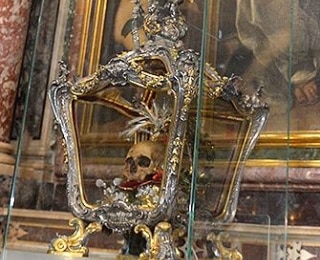The Armenian Apostolic Church has dedicated three Commemorative feasts to the First Armenian Patriarch St. Gregory the Illuminator. According to the Armenian Church calendar, the Persecution of St. Gregory the Illuminator is the first feast celebrated on the Sabbath of the 6th Sunday of the Great Lent.
Saint Gregory the Illuminator Entering “Khor Virap” pit
Returning to Armenia, Gregory had become a Royal Officer and had grown closer to King Trdat, Son of Khosrov. Upon discovering that he is a Christian and the son of Anak, King Trdat tortures him and throws him into the underground dungeon of Khor Virap.
According to historical sources, Saint Gregory the Illuminator was the son of the prince Anak Partev(Parthian), who killed the Armenian prince Khosrov of the Armenian Arshakuni Dynasty. Gregory was raised and educated in Caesarea, and brought up as a devout Christian.
Saint John Chrysostom’s “Golden Mouth” about Saint Gregory The Illuminator
In his Eulogy on Gregory the Illuminator, Saint John Chrysostom “Golden Mouth”, the 4th Century saint of the Universal Church, wrote:
“Remember his patience in the deep pit, how distressed with tribulation … no words can express the infinite ascetic life of the blessed, or explain by the example of his unbearable distress that he lived among vipers and carps, where there was neither anyone to talk to, nor a compassionate friend, no helper, no comforter, and no servant.
He endured with great patience as if buried alive in a tomb, homeless, naked, night and day, in the summer heat or winter frost, for he was near to God. “

After suffering for 13 years in Khor Virap, St. Gregory the Illuminator, came out of the underground dungeon, spreading the light of Christ in the Armenian world, becoming the first pastor of the state-recognized Armenian Church.
The memory of Gregory the Illuminator is celebrated by other Christian churches as a pan-Christian saint.
Saint Gregory the Illuminator Exodus “Khor Virap” pit
Year 301 became the beginning of the great Armenian conversion. The Armenian pagan king Trdat orders the Hripsime and Gayane virgins’ martyrdom. The King and his Royal entourage become terribly ill.
The King’s sister is told in a dream that only the prayers of Gregory, who was imprisoned in Khor Virap, could heal the king. Gregory is being set free, healing the King.
Preaching Christianity, Saint Gregory the Illuminator And The Newly converted king Trtad proclaimed Christianity as an Armenian state religion. St. Gregory the Illuminator is sent to Caesarea, where he is ordained the first pastor of the Armenian Holy Church. Gregory the Illuminator’s Exodus from Virap is one of the great holidays of the Armenian Church, which is commemorated by the Sabbath following the feast of Hripsimeants Gayaniants, the feast day is celebrated in all churches.
Descendants of Saint Gregory: The Gregorids
Gregory married a woman called Miriam, a devout Christian who was the daughter of a Christian Armenian prince in Cappadocia. From their union, Miriam bore Gregory two children, their sons Vrtanes and Aristaces.
According to Historian Abraham Terian, The “Gregorids” were an Armenian noble family descended from St. Gregory the Illuminator (c. 257-330).
They were members of the Arsacid dynasty, whose members served as patriarchs of Armenia from the early fourth century to the death of its last male member, St. Sahak I Souren Pahlavi, in 437/439.
Following Sahak’s death, his daughter, Sahakanoysh Souren Pahlavi, princess of Armenia, carried the Gregorid domains in the western provinces of Greater Armenia into the family of her husband, Hamazasp I Mamikonian, and the patriarchate of Armenia ceased to be a hereditary office.

Discovery Remains of the Saint Gregorio Armeno
Gregory the Illuminator concludes his final years of life as a hermit on Mount Sepuh, where he died in 326.
His body is found by shepherds who, without recognizing the deceased Catholic, cover the body under a rock. St. Gregory the Illuminator announces the location of his remains to one of his pupils, Garnik Basentsi, after which the relics are moved to the Tordan village of Daranagh province.
The relics of Saint Gregory the Illuminator are one of the greatest sanctuaries of all Christian churches, with some of them consecrated as sacred relics in Vagharshapat, Byzantium, and Italy.
Saint Gregory the Illuminator’s relics in Echmiadzin are one of the most important sanctuaries of the Armenian Church, during the blessing of the sacred Muron (Holy Anointing Oil).
The Feast of the Discovery of Gregory the Illuminator’s Monuments is celebrated on the fourth Saturday after Pentecost and is celebrated in Divine Liturgy at the churches of St. Gregory the Illuminator. On the occasion of the feast, the Armenian Church established a Sabbath.
On his commemoration day, The Armenian church puts the Relics of the saint on display so that the believers pay their respect to him and be blessed by him.
His remains are scattered head is believed to be now in Armenia, his left hand at the Mother See of Holy Etchmiadzin, and his right at the Holy See of Cilicia in Antelias, Lebanon.
In the 8th century, a group of nuns fled to Italy escaping the Byzantine occupation and seeking refuge within the Catholic church and built San Gregorio Armeno church on the remains of a Roman temple in Naples. The church is home to the relics of Saint Gregory the Illuminator.
